
The concept of tandem anchoring is very popular amongst the boating community. On internet message boards, the topic seems to be raised nearly as often as discussions on anchors themselves. This article is intended to provide an overview of tandem anchoring and to address the more common queries.
Using multiple anchors on boats is fairly common, and various well recognized arrangements exist for handling particular situations. For example, a bow-and-stern arrangement may be used to hold a boat into a swell in order to minimize rolling, or a Bahamian Y moor may be used to deal with frequent 180 degree veers such as when anchored in a tidal area.
“Most boaters should never have cause for tandem anchoring. Your primary anchor should be sized so that it is adequate on its own in practically all conditions – if it is not, then upgrade. [The tandem anchoring] functionality is provided for those more ‘extreme’ adventurers who require it.”
– Rocna Anchors User’s Guide
A tandem anchor set-up is intended to simply maximize holding power. It does not deal with complex situations for which another rig may be more appropriate, and works best at dealing with strong winds from a single direction. There is one point that should be strongly emphasized, and that is the fact that any multiple anchor rig introduces a complexity to an anchoring set-up that is undesirable. Your primary anchor should be sized to be good enough on its own for most all situations – if it is not, reconsider your choice of that anchor. Tandem anchoring is for extreme situations, in which a single anchor large enough alone would not be practical for daily use.
Let’s pause to reiterate this. It is a mistake to think to tandem anchor regularly. You must have a primary anchor of a good size and type for your boat. If not, get one.
A Presupposition
Throughout this article, we are assuming that a single anchor on its own, for whatever reason, is inadequate. Clearly there is no point in using a tandem rig if a single pick will do the job. While this might seem obvious, it is important to point out, as it implies that a single anchor of any multiple anchor rig will drag if all the load on the boat is applied to that one anchor. This is a situation which frequently needs to be considered.
Overview and Terminology
A tandem anchor rig is where two anchors are somehow connected in line with each other, on a single rode which is deployed from the boat. “Rig” refers to the entire system deployed in the water, i.e. anchors and rode, including shackles and/or swivels.
There is no standard for this, but for this article the terms will be defined as follows. The primary anchor is the aft-most anchor, i.e. that closest to the boat. The tandem anchor is the forward most, i.e. that out in front of the primary.
The rode is split into two sections, the primary rode and the tandem rode. The tandem rode is either attached to the front of the primary anchor or is simply an extension of the primary rode.

The Alternative
A modified Bahamian moor, where two anchors are deployed from the boat in the form of a V or Y shape and the boat can hang on both simultaneously, is often considered an alternative to a tandem rig. It has some advantage in that it can help reduce swinging or “sailing” at anchor as the two anchors both exert some lateral restraint on the boat.
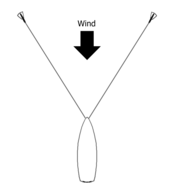
However, in the interest of maximizing holding power, it offers a false security. It is almost impossible to get the load on the boat distributed equally on both anchors, even while the wind is in the exact direction for which the anchors were set. Rather, the stress can oscillate from one anchor to the other, and if the stresses are enough to justify the use of dual anchors in the first place (otherwise why bother with the second at all?), the two anchors may simply be “walked” downwind.
This set-up is also completely incapable of dealing with veers in the wind direction. If it survives such a veer at all, the two anchors will be out of rank, and the now windward one will have to drag back into line with its opposite number. At this point, the two anchors will be closer together than before, and such a process continued could see the two anchors meet and foul each other.
A further disadvantage is the requirement to use two identical anchors, or else accept a total reduction of the capacity of the rig to the lowest common denominator. For example, if one sets a Bahamian moor with a 20 kg anchor and a 30 kg anchor of the same type, the maximum capacity of the rig is defined by the point at which the 20 kg will drag, whereupon the entire system fails and the extra size of the 30 kg anchor is wasted.
Theoretical Considerations
Once the decision has been made to use a tandem anchor rig, there are certain rights and wrongs. Unfortunately there exists little material on these issues, and much misinformation is distributed based on hearsay and poorly conceived notions. Grouped here are some basic rules, together with the theory on which they rely.
Never attach the rode of the tandem anchor to the front of the primary anchor…
…Unless the primary anchor is designed for it, i.e. has a dedicated attachment point intended for a tandem anchor.



Above: CQR, Bruce, and Delta crowns – these holes are not for tandem anchors!
Below: Dedicated tandem anchor attachment point on a Rocna (lower hole)
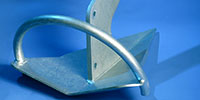
Most anchors have a hole near their crown. However, this is not an attachment point for a tandem rode! It is for a trip line. Never use it for the tandem anchor, as it will unbalance the primary anchor when load is applied. It is also frequently not strong enough, intended only to take the weight of the anchor itself. From one cruiser: “I’ve torn the trip hole out of a 110 lb CQR. Mexican panga caught the float and pulled it at about 25 knots. No corrosion, just ripped the shackle right through the steel of the anchor.”
Anchors which cannot have tandems attached directly to them include the CQR, Bruce, Delta, Spade, and Danforth types.
The only anchor which has a tandem attachment point, designed and tested specifically for this purpose, is the Rocna. This is because the designer wished to be able to use a tandem set-up when cruising in Patagonia and Antarctica, and made sure to include such functionality on his new development.
Lacking such a dedicated attachment point, the tandem rode should be connected to the primary rode at the same place as the primary. In practice this means that the tandem rode will probably actually be the primary rode, with the primary attached a distance up it. The disadvantage with this is that the rode leading from the primary to the tandem must pass alongside the shank of the primary, which could interfere with it.
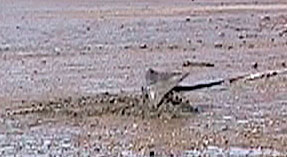
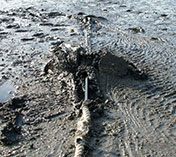
It is ideal to use anchors of identical types
This relates to the practical issue as described below that it is difficult to set both anchors after deployment. Usually one must set the primary, and trust the tandem will set itself once the primary begins to drag. To have reliable knowledge that this will happen, what better test than an identical anchor having set only a few meters away?
The two anchors do not have to be of the same size, although a great disparity is undesirable.
“The tandem anchor technique is a very good technique with Fisherman anchors, and I personally did some experiments when the Glénans’ boats only had this type of anchor onboard.
“However, I began one day to have doubts when seeing tandem anchored boats dragging. I thus carried out a series of measurements of holding with a powerboat. Almost all the tests gave the same results: one required 200 RPM to drag two anchors in tandem (CQR or Fluke anchors), less than only one of these anchors alone. I investigated what had occurred with smaller anchors on the dry beach of Pen Maryse in the Glénans, pulling by hand.
“First problem with the CQR: it has no hole to attach the second anchor (that should have been reason sufficient for not using this technique). I tested the shank, the trip line hole, and the elbow of the shank. On these three points, the effect is the same – the articulation has a bad effect; the plow cannot dig in. There remained the extremity of the shank, but it was not better. Almost each time, the chain came to obstruct the plow. The whole system depends solely on the most distant anchor. If this one is smaller, it holds less than the large anchor alone. I noted too that an anchor holds very badly in the furrow of another.
“With the ‘fluke’ anchors [Danforths]: again the same problem of dedicated attachment, and there is nothing which can be used except sometimes the trip line rings which are usually not strong enough. However, from time to time I obtained results comparable with the holding of only one anchor.”
– Jean-Louis Goldschmid of the Nautical Center of Glénans (translated from the original French)
Never use an anchor unreliable at setting as the tandem
In addition to using identical types, one should never use a type which is known to be unreliable at setting per se. It is no good dragging your primary plow for 10 meters before getting a set, and hoping that the plow tandem will perform similarly. The reality is it may drag 100 meters before setting, and that may be too far.
Most older “traditional” types are not terribly reliable at setting. Articulated plows such as the original CQR can require multiple attempts to get them to bury. Fixed shank plows such as the Delta are better. Claws like the original Bruce are better than the plow, but not necessarily in hard sand, where they can lie on their back and fail to right themselves.
Danforth types including the Fortress are shocking and are absolutely to be avoided. They are not general purpose anchors, and have no place in a tandem rig.
New generation anchors which have been demonstrated to set reliably are the best bets. These include the Spade, Bulwagga, and Rocna. Having said that, many new anchors promise everything yet deliver little, so check carefully for credible test results and other users’ experiences.
Always use the larger anchor as the primary
If there is a size difference, use the larger anchor as that closest to the boat. The reason for this is that while the primary anchor must deal with only its share of the horizontal pull, it is subjected to 100% of the vertical load (the load on the tandem is parallel to the seabed). The heavier anchor of the two will better handle this.
Always use chain for the tandem rode
While nothing is perfectly rigid in the scientific sense, as much rigidity should exist between the two anchors as possible. This is so when load is applied to the primary anchor, the tandem is immediately made to share its portion of the burden, rather than allowing the primary to shift.
The best way to do this is to use only chain between the two anchors. Never use any form of rope. This also has the benefit of ensuring the rode is resistant to any abrasion suffered from being on the seabed, which may contain coral or rock.
There is no benefit to be gained from the catenary of the chain’s weight between the tandem and primary. Accordingly, the chain can be as light as possible, subject to strength requirements, which would make high tensile grades attractive options for this purpose. However, practical considerations such as availability of existing lengths, and compatibility with windlass/capstan wildcats, will probably overshadow this point.
Use an adequate length of chain for the tandem rode
A rode the length of the boat is a good rule of thumb. A few meters is not enough, as enough slack is required to permit the primary to set before the tandem. Also, a greater length will better allow the system to deal with a veer in the pull direction. A sharp reversal may involve the primary dragging back past the tandem, and the anchors should not be too close together lest they foul each other.
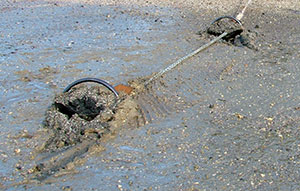
While possible, this is very difficult to do from a boat
Always set the primary anchor first
This topic is expanded on below, but there is a theoretical element to it also. For an anchor to set properly, the pull on it needs to be linear and close to horizontal. The primary anchor will not easily set with the tandem already buried, regardless of how it is attached to the rig.
If this rule is not followed, the tandem will apply a negative horizontal force, which will require greater overall loading in order to set the primary, which will introduce a level of vertical force which would not otherwise be necessary. This may prevent the primary setting at all.
It is theoretically possible to set both anchors simultaneously, but doing this in practice is all but impossible.
Accept that doubling holding power will require doubling scope
By no means must scope be doubled, but it should certainly be maximized. In theory, if it is not doubled, it will not be possible to achieve the full potential of the anchors.
For example, if one sets a 20 kg anchor on a scope of 7:1, this system will offer a certain maximum capacity for holding. Add another 20 kg anchor in tandem, and the holding capacity should double, right?
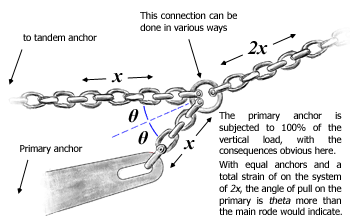
Wrong. As mentioned above, the primary anchor has to handle 100% of the vertical load – it is not possible to distribute the vertical component of the load between the two anchors, and, unless the anchors are set on a dry beach horizontal with the boat, there will always be such a vertical component.
The only way to deal completely with this extra load is to increase the scope. The maximum angle of pull on the primary anchor must be minimized. The more scope, the better – although, in practice, any scope ratio past about 8:1 brings less and less benefit. Further, do not imagine that heavy chain is a good idea; catenary in a tandem rig’s rode will always be negligible, as the rode will spend most of its time bar-tight regardless of the weight of the chain (assuming the tandem anchor is required in the first place). It is more important to ensure that the chain and rope in the primary rode is adequately specified and is strong enough. For more on catenary and scope, study the article “Catenary & Scope In Anchor Rode”.
Don’t bother with kellets (AKA anchor angels or buddies)
Kellets are supposed to increase the holding capacity of an anchor system by holding the rode low and hence keeping the angle of pull on the anchor closer to the ideal of parallel to the seabed. In practice, their effect even when deployed in an optimal point on rode (close to the anchor) is very minimal and the high loads which must be expected on a tandem rig will straighten the rode very quickly. They have negligible effect on ultimate anchor performance in a regular anchoring set-up, and even less when tandems are deployed. For more on kellets, study the article “Anchor Rode Kellets”.
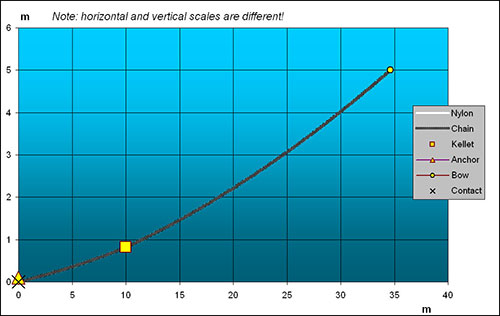
Source: “Mixed Rode Calculations” spreadsheet by Alain Fraysse
In the context of overall efficiency, the kellet is a bad investment also. The weight of the kellet used instead in the form of a larger anchor is a far more sensible tactic. Figure 7 shows an anchoring system with 35m of 10mm chain, a 10 kg kellet at the square symbol, and a load of 500 daN (equivalent weight force of 510 kg) applied to the rode. An appropriate anchor for this system might weigh 15 kg, and such an anchor on its own, let alone with a tandem, could be expected to hold far greater loads than in this example. Increasing the anchor’s size to 25 kg and losing the kellet would maintain the same overall system weight, but massively increase the holding power.
Kellets are useful in other contexts, and have an application in containing swing radii in light conditions. However, in the context of a tandem anchor rig, they are pointless.
Your tandems may offer betting holding than a single anchor of the same total weight
This is no “do” or “don’t”, but rather an interesting point to add to the theory. The holding power of an anchor is determined by the volume of soil it displaces, and thus its mass. However this relationship is not quite exactly linear. Rather, when calculating the holding power of a larger anchor based on its weight and some performance factor, the equation for most anchor types raises the mass to the power of something just over 0.9 (rather than 1). This means that two anchors can in theory hold slightly more than one large one of the same summed weight, but the difference is small.
Reality check: this theory is not perfectly consistent with small anchors, which are the interest of most readers of this article. One counter-argument to this is the fact that seabeds are typically layered, and a larger anchor may be able to get its tip down into a harder substrate than two smaller versions could, negating the theoretical benefits.
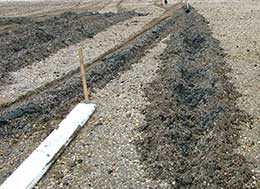
A Misconception
A common piece of misleading advice is that tandem anchors are to be avoided because the tandem will not hold well in the trough of the primary. The argument relies on the fact that the primary has plowed the seabed, and that this sand, mud, or clay will be loose and offer poor holding.
This is a logical fallacy. If both anchors have dragged far enough that the tandem has entered the furrow of the primary, assuming an adequate length of rode between them as discussed above, then the rig has failed in any case and the point may be considered moot. An adequate length of tandem rode will ensure that the tandem will always be a safe distance away.
Furthermore, the assumption that the ploughed seabed offers reduced holding is not necessarily true. In fact, in harder seabeds, it may offer better holding, as the anchor can bury more deeply into it.
Practical Considerations
This section is shorter than “Theoretical Considerations”, but only because the theory applies directly to the practice and much applied material has been covered already. Here are listed some points which apply exclusively to the real world, which no computer or mathematical model can simulate.
Consider carefully these issues. Deployment and retrieval are far more difficult with a tandem rig, particularly if the boat, and its roller assembly and foredeck, is not designed for it.
Deployment
Presented here is a recommended method for arranging and deploying a tandem rig. There are no hard and fast rules concerning this, and you may do what makes sense to you.
There are some requirements for the technique described here, but such requisites should not be considered unreasonable if one seriously intends to make use of tandem anchors in the first place. Dual bow rollers is a necessity unless the tandem anchor is very light (it shouldn’t be, as this would imply the primary anchor could be upgraded to an adequate size which would still be manageable). Cleats on the foredeck are also required, port and starboard, plus preferably a windlass with both rope and chain gypsies.
Before deployment, install both anchors in their respective rollers. If they do not fit alongside each other, the tandem (first to be deployed) could be hung just over its roller. The tandem rode should be in place, either shackled to the appropriate attachment point on the primary or being an extension of the main rode. This length of chain should be outside the pulpit, ready to go overboard.
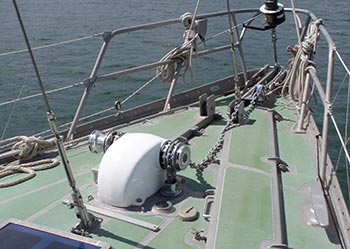
A floating retrieval line is going to be used between the two anchors to facilitate deployment and particularly retrieval of the tandem. This line should be a few meters longer than the tandem rode, and if it floats there will be no possibility of it fouling the anchors (regular retrieval lines attached to a buoy should not float, as their slack will collect on the surface and be an obstacle for the boat’s prop to foul).
Attach one end of this line to the rode attachment point of the tandem, and the other to that of the primary (or a bit farther up the chain, closer to the boat – this is for ease of accessibility).
The tandem anchor itself is for the time being kept on the boat with its retrieval line, which is cleated on the foredeck. When ready to deploy, dump the tandem rode over the side. With the boat drifting aft slowly, let out the tandem until its chain rode takes up and it is hanging from the primary (in practice it will hit the bottom first unless you are in deep water). Abandon the retrieval line at this point.
Now launch the primary anchor. Make sure the boat has drifted back far enough that it cannot land too close to the tandem, but not so far that the tandem rode is nearly straight. A little space is required in which to set the primary. Finish the deployment by letting out as much scope as you can.
Setting the anchors
An aside: do not set any anchor with reduced scope. It is common to do this, only to let out more scope once “finished”. In practice, this may result in a poor set.
After deployment as above, back down and set the primary in the normal fashion. Do this hard and make sure it is set well. In harder bottoms, you will probably not be able to drag the primary in reverse, unless you have a powerful engine. It is important to know the tandem will set itself when required, and the behavior of the primary at this point will confirm this.
In soft mud, you may be able to drag the primary, in which case you should, until the tandem sets in turn. At this point your tandem rig is deployed.
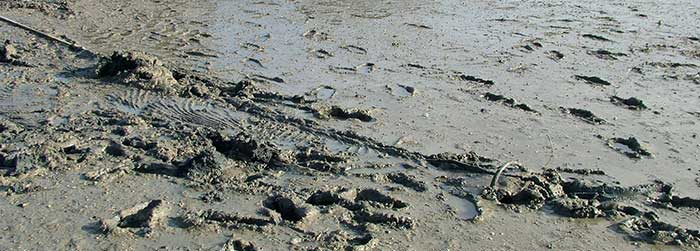
Wind veers
In some conditions which you may wish a tandem rig to handle, such as hurricanes, veering winds are likely. Changes of direction of pull have the effect of “raising the bar” for the considerations discussed so far, such as ensuring appropriate types are used and with an adequate tandem rode. A mistake or shortcut is more likely to be exacerbated and the consequences felt.
Assuming the presupposition above remains true (that a single anchor is inadequate), the primary anchor will always need to be directly between the tandem anchor and the boat. This means that if the direction of pull alters, the primary must drag into line. An anchor which is roll-stable, i.e. can drag without popping out, and one which which will remain embedded whilst being twisted around, is critical. Such types are not necessarily common, and most older types such as plows and claws suffer from a lack of these characteristics.
It should also be noted that while scope should be calculated based on the primary anchor’s rode length, the boat’s maximum swing circle will be determined by the total rode length.
Retrieval
This is where the floating retrieval line will play its part. Pull up the primary anchor until the retrieval line of the tandem is accessible. Bring this line to the other roller, and haul up the tandem. The maximum weight being pulled in this step is that of the tandem plus half the length of the tandem rode – you may be able to do this manually. If not, place the rope on the windlass.
Once the tandem is home, secure it on the roller by cleating the retrieval line. From this point on, the procedure is deployment in reverse.
Rode and equipment strength
Tandem anchoring by definition places more strain on everything. In theory the primary rode may be dealing with twice the load which the primary anchor on its own could handle. This means that all associated equipment needs to be carefully considered, including the rode itself. Is the safe working load of the chain still higher than the strain expected?
Consider also shackles or swivels as these tend to be the weakest links. Chain stops on the foredeck are recommended, even if a bridle or rope snubber is to be used.
Use snubbers or other shock absorbing solutions as you would normally. Consider also however that the forces on everything will be higher than normal, and that longer lengths of nylon may be a good idea. Chafe protection should similarly be of an extra high standard.
Swivels
While swivels are often recommended, and would be a good addition to other dual anchor rigs, they are unlikely to be useful with tandems. Swivels are useful for two reasons: they allow a boat to do multiple 360s around its anchor without kinking or twisting the rode, and they facilitate retrieval if a section of the rode deployed is rope (as the anchor is not likely to come up the correct way to mate itself with the roller, as it would if the chain’s orientation on the gypsy is maintained).
The disadvantage is one of increased complexity and an additional failure point, particularly if care is not taken to select a well built and solid design. Lateral loads are the most dangerous, and it is suggested that swivels are only ever installed “in line” with the rode, i.e. with a few links of chain between the anchor and the swivel so that the applied force can only ever be along its axis.
Since a tandem rig is not intended to handle multiple 360s in the first place, the swivel has little functional benefit. With regard to retrieval, it may be of some assistance for each anchor, although since retrieval is complicated and likely to involve more work than normal in any case, it is difficult to see any large advantage.
Case Study of a Failed Tandem Rig #1
Commensurate with the note at the beginning of this article, that tandem rigs are to be avoided unless absolutely necessary, is this case study involving the UK Marine Accident Investigation Branch (MAIB). The following is from the MAIB Safety Digest, March 2006:
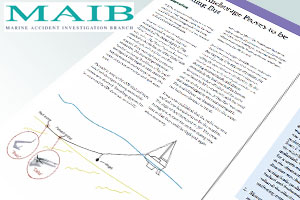
A 10.7 m steel-hulled sailing yacht was being used for a 5-day training course on the west coast of Scotland. Strong winds were being forecast for the coming night so it was decided to find a sheltered anchorage.
A bay was chosen that the skipper had used several times before and the yacht was anchored in 2.7 m charted depth. A 16 kg Delta anchor was prepared with chain and warp, and a 7.5 kg Bruce type anchor was attached to the trip line eye of the Delta with 4 metres length and a trip line and float attached. These were deployed as one unit, smaller first. This is a technique known as ‘tandem’ anchoring. In addition, a 5 kg ‘angel’ [kellet] was rigged at 20 m length of chain, and nylon warp increased the overall scope to 36 m. The nature of the bottom was fine sand with some weed.
The anchors were set for a SW wind and were tested with the engine running astern while transits were observed. Everything appeared to be secure and the GPS alarm was set to 0.03 mile (about 55 m). The barometer had been falling steadily all afternoon and, as the skipper and crew were turning in, was observed to be falling more rapidly. At this point the wind was observed to be SW force 6.
Just before midnight the GPS alarm woke the skipper. He jumped out of his berth and saw that they were 0.04 mile out of position. He started the engine and donned a lifejacket, telling his crew of four to do likewise. By the time he was on deck, the depth sounder was showing minimal depth, and almost immediately the keel touched the bottom.
Attempts to motor off failed and the yacht soon listed by 20° to starboard, with the wind and sea on the port bow. A ‘Pan Pan’ was sent and acknowledged by the local coastguard. The local lifeboat was dispatched to the scene but had some distance to travel.
It was soon established that the yacht was on a reef and was being driven on by the weather. The angle of heel increased to 30°. The crew managed to recover the anchors during this time so that they could be deployed again when necessary.
By the time the lifeboat arrived, the skipper had established that the tide was on the rise and that the depth would be sufficient for them to float off. After more movement and pounding, they eventually came clear and were able to motor north to safely re-anchor. The yacht was lifted out to inspect for damage, but was found to be unscathed.
Analysis
It is stated how the tandem (the Bruce) is attached to the Delta (the primary). This method of attachment is likely the primary cause of the system failing when the wind veered, assuming the Delta was ever set properly in the first place.
In addition to this, notice how the tandem rode was of only four meters length.
These two fundamental flaws were exacerbated by other minor mistakes. Can you identify them?
Case Study of a Failed Tandem Rig #2
Alain Poiraud, French designer of the Spade anchor, dislikes the concept of tandem anchoring and relates his experiences as follows:
“Attaching two anchors to one rode, known as tandem anchoring, should be avoided.
“The double approach attaches a second anchor with around 15′ of chain in front of the first anchor. I personally almost lost my boat trying out this idea. At the time, my first anchor dragged. Needless to say, it was an old generation model, so I decided to try something new. I added a smaller anchor in front of the large one. This worsened the holding power as opposed to doubling it, drifting swiftly on the smaller anchor while the larger one couldn’t grip at all.
“When an anchor has dragged, a trench formed behind it and this quickly backfilled with loose un-compacted sand. These areas can be still visible after several tides and may explain why some popular anchorages are criss-crossed with patches of poor holding. Then, if the most proximal anchor set, they are very good chances that the [far] anchor will fall down in this loose bottom, with, as a consequence, a poor holding!
“I have done a series of approximately 70 tandem anchorages in the clear waters of the Med, diving on nearly all of them. In 62% of the cases, only one anchor was set. During bad weather, you will not have the possibility to dive to check your anchors, and you only have to ‘trust’ your anchors, which is what I call ‘the Russian Roulette’ anchoring.
“At first, I tried to attach the smallest flat anchor (a 16 kg Brittany) with 5 meters of chain to the hole at the back of the shank of the CQR (20 kg), and I noticed that it will more or less change the equilibrium of the CQR.
“Then I move the five meters chain and attach it at the shackle of the CQR (the extremity of the main chain) but I didn’t notice any difference.”
Analysis
Poiraud’s commentary seems to indicate he routinely uses “around 15 feet” of chain for the tandem rode. While his set-up is never described in great detail, what other possible flaws can you find in his method of tandem deployment?
Conclusion
Before attempting to use a tandem anchor rig, it is critical to understand the theory. The bar is raised very high, higher probably than most sailors have the experience for. By the time a mistake is realized, it is frequently too late, the conditions not permitting any correcting action. Examples of scenarios that can arise from misunderstandings are presented above in the case studies.
In addition to studying the theory and properly planning your rig, it is suggested that you practise deployment, setting, and retrieval in manageable conditions before having to depend upon it for real.
References
- “Additional Notes On Cruising In South Chile” Andy O’Grady and Ian & Maggie Staples (Royal Cruising Club Pilotage Foundation), Chile: Arica Desert to Tierra Del Fuego 2004
- “Tuning an Anchor Rode” Alain Fraysse, alain.fraysse.free.fr
- “Avis au sujet des « ancres duelles »” Jean-Louis Goldschmid, Nautical Center of Glénans, June 2007
- Rocna Anchors Tandem Testing, Rocna Anchors, July 2006
- “Case Study 22” Marine Accident Investigation Branch, MAIB Safety Digest March 2006
